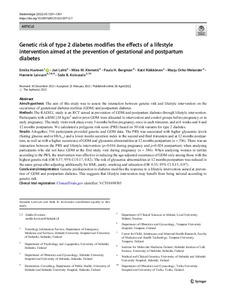Genetic risk of type 2 diabetes modifies the effects of a lifestyle intervention aimed at the prevention of gestational and postpartum diabetes
Huvinen Emilia; Koivusalo Saila B.; Räikkönen Katri; Klemetti Miira M.; Orho-Melander Marju; Bergman Paula H.; Laivuori Hannele; Lahti Jari
https://urn.fi/URN:NBN:fi-fe2022081153987
Tiivistelmä
Aims/hypothesis
The aim of this study was to assess the interaction between genetic risk and lifestyle intervention on the occurrence of gestational diabetes mellitus (GDM) and postpartum diabetes.
Methods
The RADIEL study is an RCT aimed at prevention of GDM and postpartum diabetes through lifestyle intervention. Participants with a BMI >= 30 kg/m(2) and/or prior GDM were allocated to intervention and control groups before pregnancy or in early pregnancy. The study visits took place every 3 months before pregnancy, once in each trimester, and at 6 weeks and 6 and 12 months postpartum. We calculated a polygenic risk score (PRS) based on 50 risk variants for type 2 diabetes.
Results
Altogether, 516 participants provided genetic and GDM data. The PRS was associated with higher glycaemic levels (fasting glucose and/or HbA(1c)) and a lower insulin secretion index in the second and third trimesters and at 12 months postpartum, as well as with a higher occurrence of GDM and glycaemic abnormalities at 12 months postpartum (n = 356). There was an interaction between the PRS and lifestyle intervention (p=0.016 during pregnancy and p=0.024 postpartum) when analysing participants who did not have GDM at the first study visit during pregnancy (n = 386). When analysing women in tertiles according to the PRS, the intervention was effective in reducing the age-adjusted occurrence of GDM only among those with the highest genetic risk (OR 0.37; 95% CI 0.17, 0.82). The risk of glycaemic abnormalities at 12 months postpartum was reduced in the same group after adjusting additionally for BMI, parity, smoking and education (OR 0.35; 95% CI 0.13, 0.97).
Conclusions/interpretation
Genetic predisposition to diabetes modifies the response to a lifestyle intervention aimed at prevention of GDM and postpartum diabetes. This suggests that lifestyle intervention may benefit from being tailored according to genetic risk.
Kokoelmat
- Rinnakkaistallenteet [19218]
